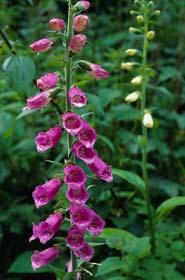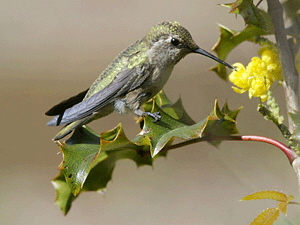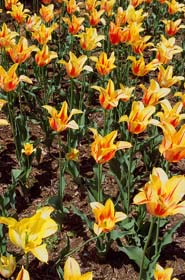


An interest in gardening frequently goes along with an interest in birds. It is not unusual for avid gardeners to grow into enthusiastic birders. It requires only suitable habitat, adequate water, and ample food to attract birds to a garden. As growth and development take up more and more of the native landscape, backyard habitat grows in importance. The decline in song-bird populations is attributed to loss of habitat in breeding and wintering grounds as well as along migration paths.
A garden design can have "bird appeal," without abridging landscaping principles. There are appropriate plant materials for any garden style---from formal to woodland. Of course, it is important to select plants that will prosper in the light, soil, and moisture conditions of your garden.
Some trees, shrubs, vines, annuals, and perennials appeal to many species of birds, while others are attractive to only a few species. Not every landscape plant has "bird appeal," but there are hundreds of plants that will enhance the landscape and at the same time furnish food for birds.
Pines such as Shortleaf (Pinus echinata), Slash (P. Elliottii), Longleaf (P. palustris), Loblolly (P. Taeda), and Virginia (P. virginiana) supply food for birds feeding both on the ground and in trees. Evergreen pines are also important for cover and as nesting sites for birds that like a forest canopy.
Oaks offer shade and cover along with a big food crop for birds. Even birds that cannot handle a whole nut get to share in the bounty by eating broken acorns found on the ground. Among the oaks seen in the southern landscape are: White (Quercus alba), Southern Red (Q. falcata), Water (Q. nigra), Laurel (Q. laurifolia), Post (Q. stellata), Shumard (Q. Shumardii), and Live (Q. virginiana).
The fruit of Flowering Dog-wood (Cornus florida) appeals to bluebirds, robins, thrushes, and 30 other birds. A popular choice in southern gardens, the dogwood offers clouds of color in spring, beautiful fall leaves followed by bright red fruit for the birds.
Eastern Red Cedar (Juniperus virginiana) is known to attract 54 species, and it will survive under widely diverse conditions. Both male and female plants are needed to produce fruit, which is borne only on the female plant.
Included in the list of native trees that furnish food and cover for birds are: Southern Magnolia (Magnolia grandiflora), Sweetgum (Liquidambar Styraciflua), Southern Crabapple (Malus angustifolia), Serviceberry (Amelanchier arborea), Smooth Sumac (Rhus glabra), and Southern Wax Myrtle (Myrica cerifera).
Hollies can be evergreen or deciduous---native, hybrid, or in-troduced. From the American Holly (Ilex opaca), which grows into a beautiful tree, to the Chinese Burford Holly (Ilex cor-nuta ‘Burfordii’), which is a prevalent landscaping shrub, there is a holly for every garden design. They supply crucial cover as well as food. The berries, which can be red, white, or black, mature at various times, depending upon the variety.
Leatherleaf Mahonia (Mahonia Bealei), Elderberry (Sambucus canadensis), American Beauty-berry (Callicarpa americana), Elaeagnus (Elaeagnus pungens), Winter Honeysuckle (Lonicera fragrantissima), Nandina (Nandina domestica), Pyracantha Pyracantha coccinea), Blueberries (Vaccinium sp.), Cranberry Bush (Viburnum Opulus),Leatherleaf (Viburnum Wrightii), and Wax Leaf Ligus-trum (Ligustrum japonicum) are readily available shrubs, which serve well in the bird garden.
Many of the vines with tubular flowers such as Trumpet Vine (Campsis radicans) and Cypress Vine (Ipomea Quamoclit) are attractive to hummingbirds. Vines that produce fruit or berries for other birds are: Carolina Snailseed (Cocculus carolinus), Bittersweet (Celastrus scandens), Southern Smilax (Smilax sp.), Grapes (Vitis sp.), Blackberry (Rubus sp.), Dewberry (Rubus sp.), and Alabama Supplejack (Berchemia scandens). The berry of Virginia Creeper (Parthenocissus quinque-folia) is known to attract at least 35 species of birds.
Perennials and annuals which appeal to hummingbirds include: Cigar Flower (Cuphea ignea), Shrimp Plant (Justicia Brande-geana), Lantana (Lantana Camara), Red-hot Poker (Kniphofia Uvaria), Cardinal Flower (Lobelia Cardi-nalis), and varieties of both Monarda, and Salvia.
Swamp Sunflower (Helian-thus angustifolia) produces two to three inch flowers, while the giant Sunflower (Helianthus annuus) bears huge flower heads. Sunflowers in the garden attract more than 20 species including: Cardinal, Carolina chickadee, American goldfinch, nuthatches, Red-bellied and Red-headed woodpeckers.
Birds in the garden add another dimension to the landscape. Including plants for birds in your garden design will bring you pleasure while providing habitat and food. Just as flowers brighten the landscape, so will birds. A drift of cardinals in the backyard will cheer a winter’s day.
Credits to the Southern Alabama Birding Association